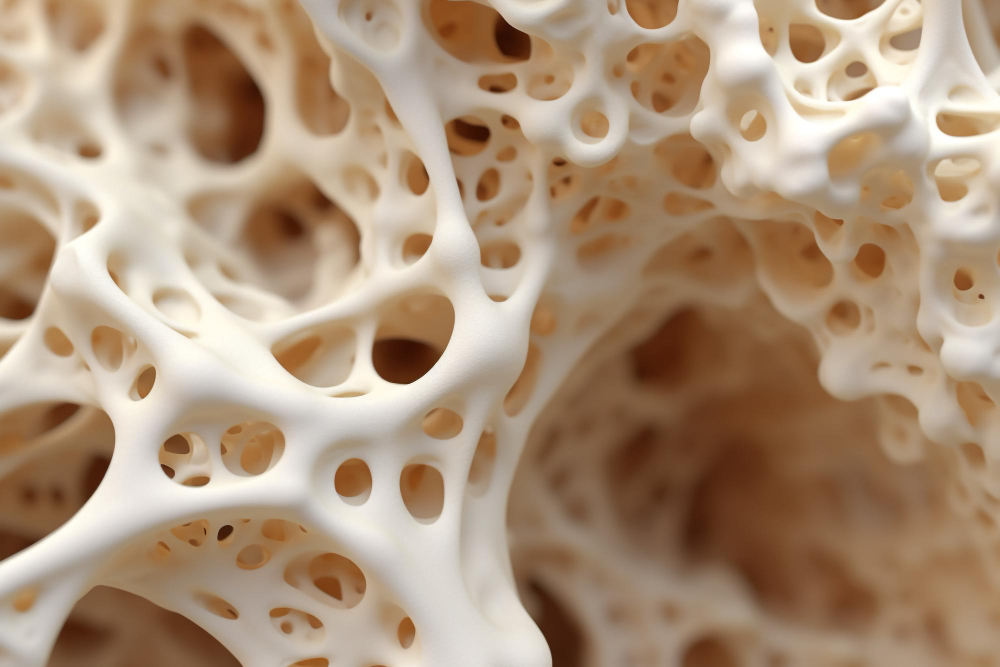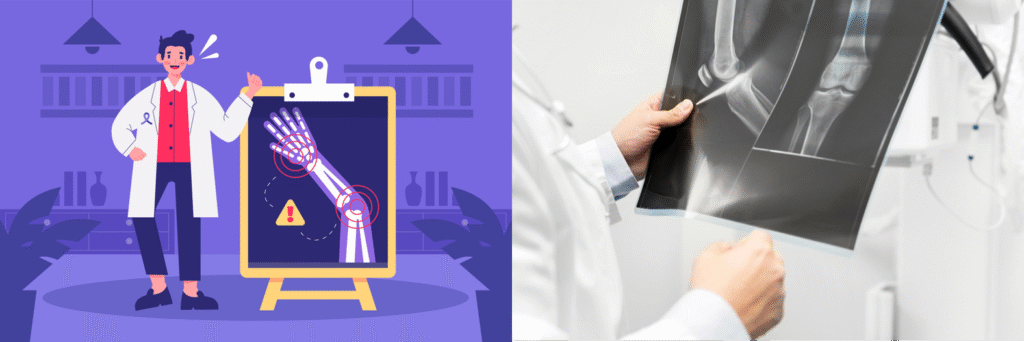
Osteoporosis is a systemic bone disease characterized by low bone mass, disruption of bone microarchitecture, increased bone fragility, and a higher risk of fractures.
The National Institutes of Health (NIH) defines osteoporosis as a skeletal disorder characterized by reduced bone strength and increased risk of fractures. Bone strength reflects two key aspects of the bone: bone mineral density and bone quality.
This condition can occur in both genders and at any age but is most commonly seen in postmenopausal women and elderly men.
Osteoporosis is categorized into two main types.
primary and secondary. Primary osteoporosis is further subdivided into postmenopausal osteoporosis (Type I), senile osteoporosis (Type II), and idiopathic osteoporosis (including juvenile types). Postmenopausal osteoporosis typically occurs within 5 to 10 years after menopause in women, while senile osteoporosis generally refers to osteoporosis that occurs in individuals over the age of 70. Secondary osteoporosis refers to bone loss caused by diseases or medications that affect bone metabolism. Idiopathic osteoporosis mainly affects adolescents, but its causes remain largely unknown.

There are many factors contributing to the development of osteoporosis, including age, gender, race, hormones, nutrition, and environmental factors. The prevalence of osteoporosis is particularly high in middle-aged and elderly individuals. According to U.S. statistics, about 25% of women over the age of 65 may suffer from one or more vertebral fractures. Bone density tends to be higher in Black populations compared to White populations, and men generally have higher bone density than women. Among the various causes, nutrition is closely linked to the development of osteoporosis.
Symptoms and Signs of Osteoporosis
- Often there are no symptoms before a fracture occurs.
- Fractures in the vertebrae, wrists, hips, humerus, and tibia.
- Vertebral damage leading to pain.
- Hunched back (kyphosis).
- Decreased height.

To diagnose osteoporosis, laboratory tests are required, such as:
- Ultrasound examination.
- Bone density test (DXA scan).
- Complete blood count (CBC).
- Parathyroid hormone (PTH) levels test.
- X-ray examination.

Preventing osteoporosis through diet and exercise
- Increase calcium intake in daily meals.
A balanced diet is one of the key measures for preventing osteoporosis. Since calcium plays a vital role in bone metabolism and is an essential nutrient for bone formation, increasing calcium intake in daily meals is an effective preventive measure. Foods rich in calcium include milk, pork ribs, cartilage, shrimp shells, seaweed, black moss, wood ear fungus, oranges, and walnuts. Additionally, eggs, fish, chicken, lean meat, beans, and bean products, which are rich in protein, should be consumed. Fresh vegetables such as amaranth, cilantro, bok choy, and fruits should also be eaten more frequently, as they provide vitamins D and C, which are important regulators of bone metabolism. Furthermore, avoid spicy, overly salty, or excessively sweet foods that can be stimulating.

- A Healthy Lifestyle Helps Prevent Osteoporosis
Exercise stimulates osteoblasts through mechanical stress from muscle tension, promoting bone formation and remodelling, which helps maintain or increase bone mass and elasticity. Physical activity during middle age offers various benefits to the body, and in older age, it not only slows down bone loss but also improves physiological functions, enhances the quality of life, and reduces the risk of falls. Recommended exercises include walking, jogging, gymnastics, dancing, cycling, and ball games. The duration of each session should be 20-30 minutes, 3-5 times per week.

A healthy lifestyle is beneficial for preventing osteoporosis. Smoking, excessive alcohol consumption, and drinking strong coffee can all increase the risk of osteoporosis. Beer, in particular, has a more significant impact on hip fractures than other types of alcohol. Therefore, it is important to consume foods rich in calcium and phosphorus, engage in appropriate physical activity, avoid smoking, limit alcohol intake, and reduce the consumption of strong coffee, tea, and carbonated drinks, while ensuring moderate protein intake.

Additionally, getting adequate sunlight is essential. The ultraviolet rays in sunlight can promote the conversion of 7-dehydrocholesterol in the skin to previtamin D3, which is then converted to vitamin D3 through skin temperature. This is absorbed through the lymphatic system and transported to the liver and kidneys, where it is further hydroxylated to active vitamin D. Active vitamin D promotes the absorption of calcium and phosphorus in the intestines, supporting bone formation and helping prevent osteoporosis.

- Recommended Medicinal Diets
i) Soybean and Walnut Chicken

Ingredients: 750g chicken, 50g soybeans, 50g walnuts, and appropriate seasonings.
Steps : Wash and cut the chicken into pieces. Soak the soybeans until soft. Combine the chicken, soybeans, and walnuts in a pot. Add green onions, minced ginger, salt, cooking wine, and water until the pot is 80% full. Steam over low heat for about 2 hours, then add a little pepper and serve. This dish nourishes the kidneys and enhances vitality.
ii) Bean Sprout Stew with Pork Ribs

Ingredients: 500g bean sprouts, 1000g pork ribs, 250g yam, and appropriate seasonings.
Steps : Wash and cut the pork ribs, season with yam, and steam in a pressure cooker until tender. Boil the ribs, add the soybean sprouts, cook until done, then season with salt and MSG. This dish strengthens the kidneys, fortifies the bones, and replenishes marrow.
iii)Angelica Lamb Soup

Ingredients: 30g Angelica, 15g fresh ginger, 200g lamb, and an appropriate amount of water.
Steps : Wash the lamb and simmer it with Angelica and ginger until the lamb is tender. Season with chopped green onions, MSG, minced ginger, and salt. Drink the soup and eat the meat. This soup warms and nourishes the kidneys, warms the meridians, and promotes circulation. It is particularly beneficial for osteoporosis caused by yang deficiency in the spleen and kidneys and cold in the meridians.
Preventing osteoporosis through diet and exercise is crucial, but it’s a long-term process that requires consistency and dedication.
此文章还有以下语言版本:
![]() 简体中文 (Chinese (Simplified))
简体中文 (Chinese (Simplified)) ![]() Melayu (Malay)
Melayu (Malay)



